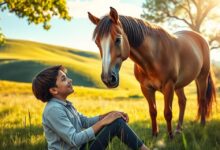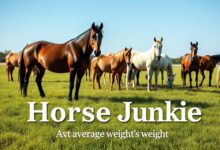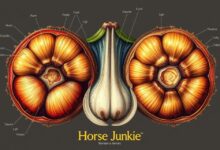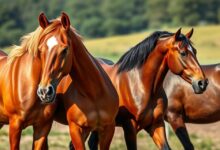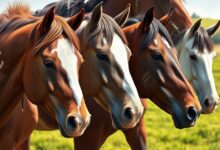Equine Glossary: Understanding Horse Terms
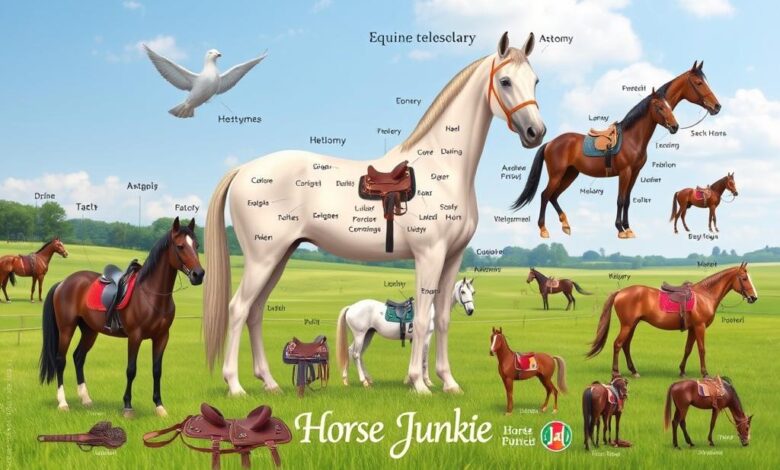
Ever wondered how horse language can make our bond with them stronger? In the world of horses, knowing their terms is key. It’s not just nice; it’s necessary. By learning the equestrian glossary and equine terminology, we can talk better with horses. This guide will help you understand horse talk, making you appreciate these amazing animals more.
Key Takeaways
- Understanding horse terms is essential for effective communication in the equestrian community.
- Equine terminology helps mitigate misunderstandings among horse owners and riders.
- Familiarity with an equestrian glossary can enrich our experiences with horses.
- The shared vocabulary enhances relationships with equine companions.
- Knowledge of horse terms aids in better horse care and training.
Introduction to Horse Terms
Knowing horse terminology is key for anyone in the equestrian world. Without it, we might find it hard to talk about horse care, training, and health. A good vocabulary helps us connect with others, whether we’re talking about horse competitions or our horses’ daily needs.
Importance of a Shared Vocabulary
In the equestrian community, everyone needs to know horse terms. This includes riders, trainers, vets, and fans. A common language makes our talks clearer, helping us share ideas about our horses.
When we talk about a mare, stallion, or different gaits like lope and gallop, we help everyone understand better. This makes our community stronger.
Purpose of Horse Terminology
Horse terminology helps us describe actions and items safely and enjoyably. For instance, knowing the difference between a bridle and a saddle is vital for handling horses right. Knowing equestrian language improves our horse experience, helping us bond with them more deeply.
Basic Horse Anatomy Terms
Learning about horse anatomy is key for anyone who works with these animals. Knowing the right terms helps us talk about their structure better. Terms like cannon, fetlock, and croup are important for checking a horse’s health and how well it performs.
Understanding Horse Structure
Every horse’s body is unique, affecting its balance and how it moves. Since horses don’t have collar bones, their movements are different. Important parts include:
- Muzzle
- Poll
- Crest
- Neck
- Shoulder
- Withers
- Knee (Carpus)
- Cannon
- Fetlock
- Pastern
- Hoof
- Croup
- Hip
- Stifle
- Gaskin
- Hock
Knowing these terms helps us communicate better with horses. It ensures we meet their needs and keep them healthy.
Key Terms Related to Movement
To improve riding and training, we need to understand horse movement. The walk is a four-beat gait, moving at about 4 mph. The trot, a two-beat gait, is faster, at 8 mph. The canter, a three-beat gait, is quicker, moving between 10-17 mph. The gallop is the fastest, reaching speeds of 25-30 mph.
Knowing about horse movement helps in training and vet care. Each gait shows a horse’s athleticism. Being aware of this is crucial for their health and well-being.
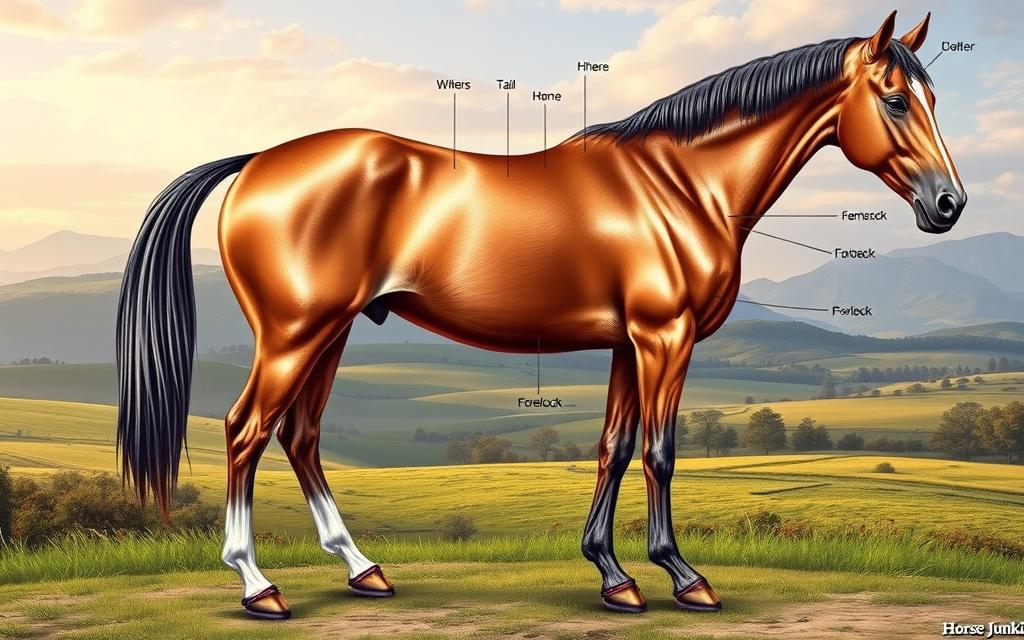
Breed-Specific Terminology
Learning about horse breed terminology helps us appreciate the unique qualities of different horses. Knowing about popular breeds helps us make better choices for riding, competitions, or just having a horse as a friend. Each breed has its own special terms that describe its traits and uses.
Popular Breeds and Their Characteristics
Popular horse breeds have special traits for different riding activities. For instance:
- The Arabian breed is known for its long-distance endurance and elegant look.
- Thoroughbreds are famous for racing, showing off their speed and agility.
- Quarter Horses are great for short races, like quarter-mile ones, because of their quick start.
- Mustangs symbolize the American West, known for their toughness and ability to adapt.
Terms Related to Breed Identification
Knowing how to identify horse breeds is key for horse owners or trainers. Certain terms are crucial for making the right choices. For example:
- Foals are baby horses up to one year old.
- Fillies are young female horses under three, still growing.
- Mares are adult female horses, ready to have babies.
- Colts are young male horses, still growing.
- Stallions are adult male horses over four, known for breeding.
- Geldings are male horses that have been neutered, often calm.
- Sires are stallions that have fathered horses, important for family lines.
Knowing these terms helps us identify breeds and choose the right horse for activities like dressage or just riding for fun. Learning about these terms makes our time with horses more meaningful.
Riding Equipment Terms
Knowing the terms for riding equipment is key for both new and seasoned riders. We dive into tack terms and essential items for safety and function. Good communication is vital in the riding world.
Common Tack Components
In horse riding, some terms are crucial to learn. Tack is the term for all riding gear. Important parts include:
- Saddle: This is the rider’s seat, important for control and comfort.
- Bridle: A headpiece with the bit, letting the rider steer the horse.
- Girth: Also called the cinch, it holds the saddle on the horse.
- Reins: Key for talking to the horse.
- Headstall: Goes around the horse’s head, attaching the bit.
- Shanks: On curb bits, they affect the riding feel.
- Curb strap: Under the jaw, it’s key for some bits.
Specialized Riding Gear
There’s also specialized gear for better performance and safety in different riding styles:
- Martingales: Stop the horse from lifting its head too high.
- Bell boots: Keep the horse’s hooves and legs safe.
- Stirrups: Give the rider a place to put their feet and balance.
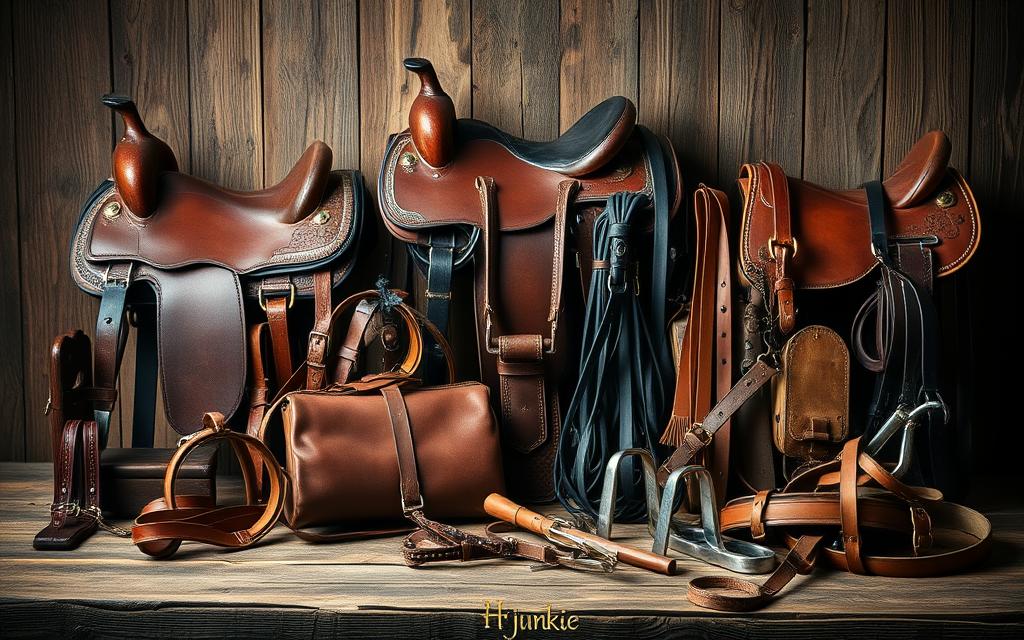
Learning this vocabulary helps us talk to and care for our horses better. Using gear right makes our rides safer and more enjoyable for both us and our horses.
Horse Behavior and Training Terms
Knowing how horses behave is key for anyone working with them. Learning important terms helps us talk better with our horses. This makes our work together more effective. We’ll look at important ideas in horse psychology and common training words.
Understanding Equine Psychology
Understanding horse behavior is crucial. It helps us see how they see the world and react to us. Key terms like body language are important. They help us know when a horse is happy or ready to work. Here are some key terms:
- Comfort zone: This is where a horse feels safe.
- Consistency: It’s vital for training. It means our signals are clear and easy to follow.
- Counterconditioning: It’s a way to help horses feel better in scary situations. We pair scary things with good experiences.
Common Training Terminology
Knowing common training words helps us use good techniques. It makes our training sessions better. Here are some important terms:
- Clicker training: It uses a special sound to mark good behavior, then rewards it.
- Back-chaining: We teach the last part of a behavior first. Then we add the earlier parts until it’s all learned.
- Chaining: It’s about linking tasks together. Each task builds on the last one.
- Capturing: It’s rewarding a horse for doing something good on their own.
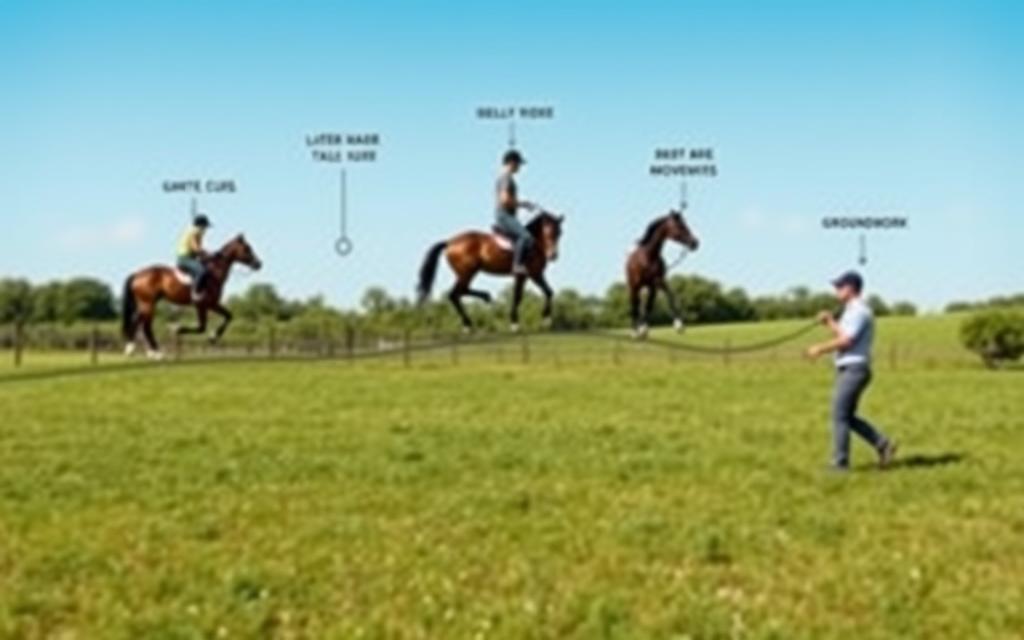
Veterinary Terms for Horse Owners
Knowing veterinary terms is key for horse owners. It helps us spot health problems early. Terms like vaccine, colic, and laminitis are important for our horses’ health.
Essential Health Terms
Knowing horse health terms helps us talk better with vets. Understanding colic, a severe belly pain, lets us act fast. Laminitis, a hoof inflammation, shows how vital hoof care and diet are.
Common Medical Procedures Explained
Knowing about horse medical procedures is crucial for care. Deworming and vaccination schedules are key. Vaccines fight off diseases, and deworming keeps parasites away.
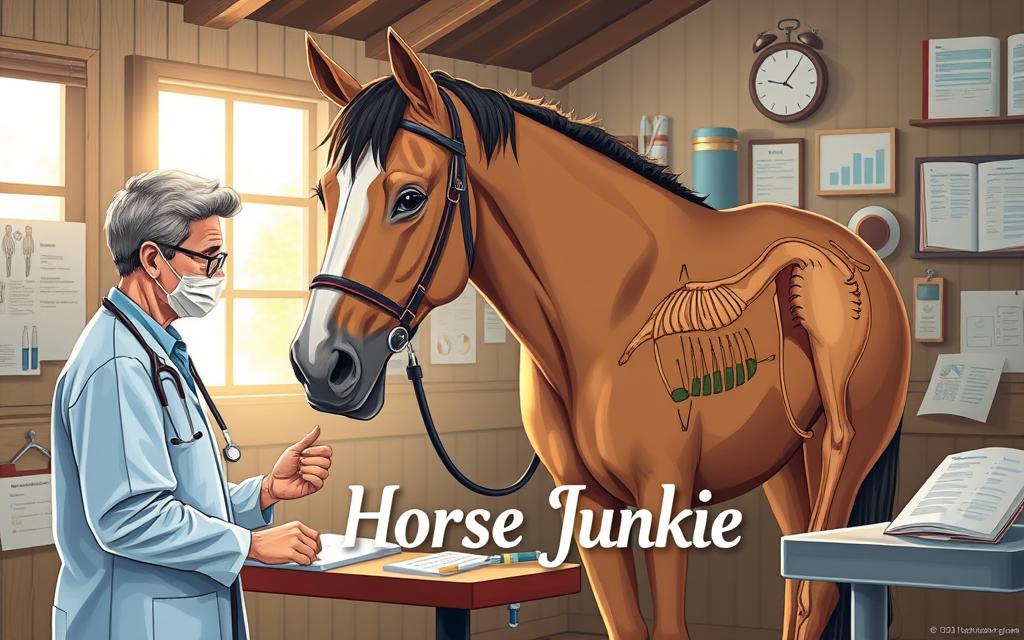
Grooming Terminology
Grooming is key to a horse’s health and looks. Knowing horse grooming terms helps us groom better. It lets us pick the right tools and methods for our horses.
Tools and Techniques for Grooming
Choosing the right grooming tools is vital for a horse’s coat and cleanliness. Some must-haves include:
- Curry comb
- Stiff brush
- Soft brush
- Hoof pick
- Mane and tail comb
- Pulling comb
- Scissors
- Clippers
- Shedding block
- Sweat scraper
Each tool has its role, from cleaning dirt and hair to keeping hooves healthy. For example, currying boosts skin health and spreads natural oils. Picking hooves removes debris that could harm the horse.
Important Grooming Practices
Having a grooming routine is crucial. A full grooming session usually lasts about 30 minutes. It’s best to bathe a horse once a week to keep their natural oils.
For show horses, clipping should happen a few days before the event. This lets any lines fade. Also, some disciplines require specific mane and tail styles.
It’s important to know the rules for grooming at shows. For example, AQHA rules ban hoof polish. Knowing these terms helps us meet the rules and show our horses at their best.
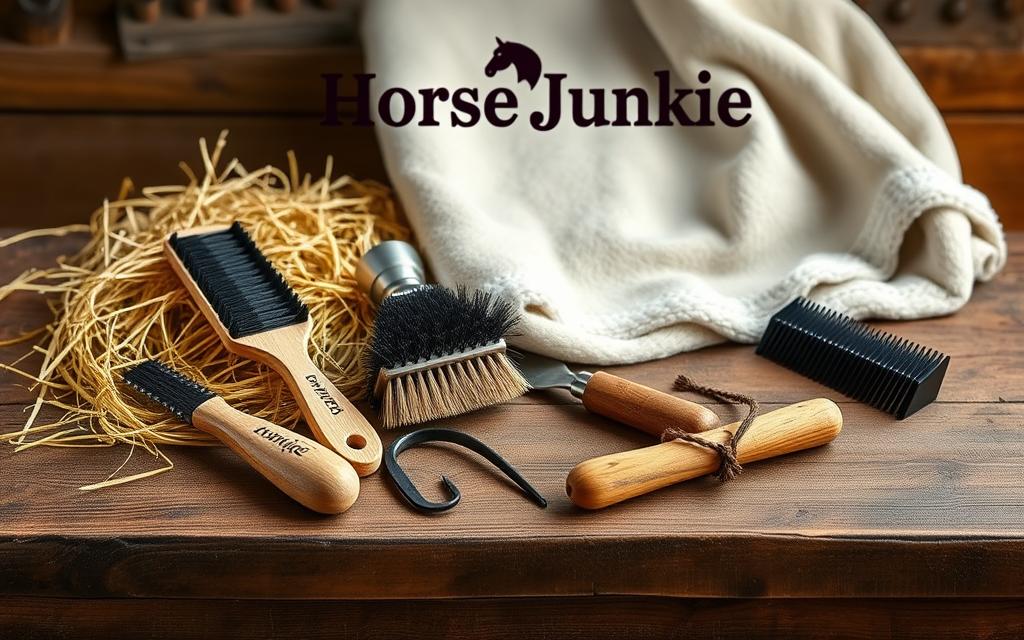
Horse Shows and Competitions
Learning the language of horse shows and competitions makes our equestrian journey better. We come across different terms that sort events into classes. Each class has its own challenges, and knowing the specific vocabulary is key to success.
Competitions: Types and Terminology
Horse shows include many types, like dressage and jumping. Each event has its own set of terms that guide our preparation and performance. The main categories are:
- Dressage: A test of precision, where movements highlight the horse’s training and rider’s skill.
- Hunter: Focuses on the horse’s style and smoothness over jumps, judged on performance and appearance.
- Jumping: Tests agility and speed, requiring a combination of technical skill and boldness.
There’s also general vocabulary we need to know. Terms like “course,” “round,” and “fault” are crucial for navigating horse shows.
Judging Criteria in Horse Events
Knowing what judges look for in horse shows is very helpful. We should consider several factors, such as:
- Technique: The horse’s method of executing movements and obstacles.
- Style: The overall presentation and harmony between horse and rider.
- Consistency: Performance reliability across all rounds or classes.
Understanding these criteria helps us prepare better for competitions. Knowing what judges value helps us focus our training.

Terms Related to Horse Care
Knowing horse care terms is key to keeping our horses healthy. Daily tasks need the right knowledge and care. Learning these terms helps us in our daily work and prepares us for seasonal changes.
Daily Care Responsibilities
Our daily tasks for our horses include:
- Feeding: Horses need about 2% of their body weight in food daily. This includes hay, grains, and supplements.
- Watering: Keeping our horses hydrated is vital for their health.
- Grooming: Regular grooming stops coat problems and strengthens our bond.
- Exercise: Horses need regular exercise, like walking or riding, to stay fit.
- Hoof Care: Farriers should visit every 6-8 weeks to keep hooves healthy.
Seasonal Care Considerations
Seasonal care means changing how we manage our horses with the weather. Important points include:
- Nutrition: We need to adjust their food, especially in cold weather. Alfalfa hay has more protein and calcium than grass hay.
- Grooming Adjustments: We might need to change our grooming tools and methods with the seasons. In winter, we focus more on removing mud and moisture.
- Housing: Good shelter, like a three-sided structure, is key to protect them from the weather.
- Health Monitoring: We must watch for signs of illness or discomfort, like lameness, which means an abnormal gait.
Working Horse Terminology
Learning about working horse terms helps us manage and appreciate these amazing animals. Knowing the right words for their roles in agriculture, therapy, and more is key. By understanding these terms, we see how much working horses contribute to their fields.
Terms in the Context of Labor
When we talk about horse labor, certain terms stand out. Words like driving and riding show how horses are used for work. Also, the idea of teamwork among horses helps us talk about their roles more clearly.
- Driving: Refers to directing a horse to pull a cart or carriage.
- Team Driving: Involves multiple horses working together to pull heavier loads.
- Geldings: Most horses used for riding in labor contexts are geldings, as they are unable to reproduce, making them suitable for sustained work.
Equipment Used in Working Horses
Working horses need specific tools for their tasks. Knowing about equine labor equipment helps us manage them better. Here are some key tools:
- Harnesses: Crucial for attaching horses to machinery or vehicles.
- Vices: Devices used to hold horse legs in place during shoeing or medical attention.
- Plows: Tools employed in agricultural tasks, allowing horses to assist in tilling land.
- Driving Lines: Aids used to control and guide driving horses effectively.
Horse Feeding and Nutrition Terms
Knowing horse feeding terms is key to keeping our horses healthy. Using the right equine nutrition vocabulary helps us understand their diet needs. This part covers the basics of horse nutrition and essential feeding practices for their well-being.
Basics of Horse Nutrition
Nutrition is vital for a horse’s health. A good horse feeding program should include:
- Forage: Hay or pasture is the base of a horse’s diet. Different hays, like alfalfa or grass hay, have unique nutrients. We must choose based on our horses’ needs.
- Grains and Concentrates: These add energy, especially for active horses or those nursing. Oats are safe, but corn can cause stomach problems if not used right.
- Supplements: Foods like beet pulp can improve a horse’s diet, especially with poor hay. Soaking it before feeding helps avoid stomach issues.
- Amino Acids: Horses need 22 amino acids for health. Some must be in their diet for optimal well-being.
Important Feeding Practices
Good feeding practices are crucial for our horses’ health. Here are some tips:
- Controlling portion sizes helps avoid obesity and health problems like insulin resistance.
- Regular feeding times help with behavior and digestion, reducing risks like laminitis.
- Using balancers like Lo-Cal or Performance Balancer can balance nutrition with hay or oats.
- Keeping our horses hydrated, especially in heat, is vital. Electrolytes are important after hard work.
Conclusion: The Benefit of Understanding Horse Terms
Exploring the world of horse riding and care shows us why knowing horse terms is key. This knowledge makes our experience better, letting us manage things well and talk clearly with our horses. With the right terms, we can handle different riding styles, like natural horsemanship, better. This helps us grow in our equestrian skills.
How Knowledge Enhances Our Experience
Knowing horse terms gives us the skills we need and deepens our bond with horses. By learning about grooming, tacking up, and ground manners, we make riding safer and more effective. Whether it’s using the EquiGroomer’s blade or learning to have soft hands, our love for learning shows we care about our horses.
Building a Stronger Connection with Horses
Our connection with horses grows stronger when we share a common language and understanding. This helps us build safe and understanding relationships with them. By focusing on horsemanship basics and always trying to improve, we help ourselves and our equestrian community grow.
FAQ
What is the importance of an equestrian glossary?
Why should I learn horse anatomy terms?
How does breed-specific terminology influence horse ownership?
What are the key components of riding equipment?
How does understanding horse behavior improve training?
What veterinary terms should every horse owner know?
Why is grooming terminology important?
What should I know about horse competition terms?
What are essential daily care terms for horses?
How does working horse terminology relate to their management?
What are the fundamentals of horse feeding and nutrition?
Source Links
- Glossary of equestrian terms
- Equine Terminology | Circle R Ranch
- Horse Riding Terms for Beginners | C Lazy U Ranch
- Glossary Of Horse Terminology – Horse Terms & Definitions
- Horse Body Part Terms: A Helpful Anatomy Guide – Horse Rookie
- Horse Terminology: Gaits and Anatomy – Dan Koboldt
- Horse Terminology for the Layman
- The Gallup Glossary: Stable Definitions for Common Equine Terminology — The Pennsylvania Horse Racing Association
- Ultimate Horse Glossary for English Riders
- Horse Terms: Equestrian Lingo Explained
- Defining horse jargon: Tack and equipment terms and common misspellings
- Cowboy’s Glossary of Saddles and Gear Terms
- Dressage terminology glossary
- Equestrian glossary – words you need to know
- GLOSSARY
- Horse Terminology: Manna Pro® Equine Glossary
- Horse Health Glossary
- Defining horse jargon: Horse sale terms
- Curry Confusion: Horse Grooming Terminology for Beginners – Horse Rookie
- Glossary of Equine Terms
- Horse Care Terminology: Foreign Language or Feasible? – Horse Rookie
- Horse Terminology 101 – Your Horse Farm
- Stable Sense: Horse Barn Terminology for Rookies
- GLOSSARY OF HORSE TERMS
- 30+ Equine Nutrition Terms Your Horse Wishes You Knew – Horse Rookie
- The A-to-Z of Nutrition Terms
- What is Horsemanship? The Foundations of Horse Etiquette – Pine Hill Ranch
- How to Decode Horse Jargon: An Easy Beginner’s Guide – EquiGroomer Horse and Pet Tools


